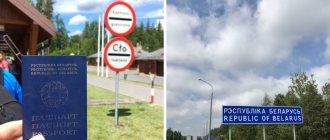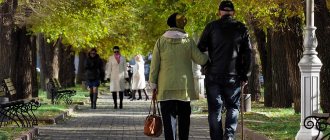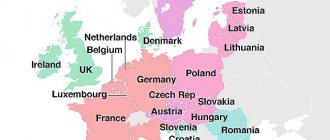A high standard of living, decent wages, social security and a large territory with varied climatic conditions are what makes our compatriots think that after moving to the United States, life will certainly improve. How Russians live in the United States depends on the method of migration, the city and the willingness to change their worldview. Whether moving to America will be the fulfillment of the American dream or a complete disappointment depends on many factors.
Waves of emigration
In all eras, the emigration of the Russian-speaking population to the United States was due to flight from repression and oppression (religious, political, racial) from the Russian Empire, and later from the Soviet Union. In history, 5 waves of Russian immigration can be distinguished:
- The first emigrants appeared on American soil in the 18th-19th centuries. It was at this time that representatives of the Russian nation founded the first settlements on the shores of the Pacific Ocean.
- The Russian diaspora in America during the second wave was represented by Jews moving from the Russian Empire and White Guard migrants. This happened at the end of the 19th – beginning of the 20th centuries.
- The third wave was not numerous and consisted mainly of political emigrants who left the USSR between the end of World War II and the end of the 70s of the last century.
- During the fourth wave, the largest number of people left the Union. The impetus for this was the fall of the “Iron Curtain” - the end of the 80s and the beginning of the 90s of the 20th century. The first to go overseas were Jews who fled the oppression of Soviet power, followed by everyone who had the opportunity and desire to leave in search of a better life.
- The fifth wave includes migrants of the early 2000s who moved to the States for political and economic reasons.
The last wave of Russian emigration continues today. It consists of those who leave for the purpose of doing business, buying real estate, or studying.
The size of the Russian-speaking population in the USA
The Russian diaspora in the United States is usually called Russian Americans who went through the naturalization process, but were born outside of this state. However, this concept does not always indicate the ethnicity of migrants. “Russians” here are considered to be people from all former Soviet republics and their descendants.
It is impossible to say for sure how many Russians there are in the United States today, since not all of them took part in the last census in 2021. We should also not discount illegal immigrants, who are not on the migrant lists at all.
According to the latest estimates, the number of Russian Americans at the beginning of 2021 was about 5 million people. Of these, more than 400 thousand were born outside the United States.
In terms of migration from CIS countries, the size of the Russian-speaking population looks like this:
- Russians – 2.6 million people;
- Ukrainians – about 900 thousand;
- Belarusians – almost 26 thousand migrants;
- representatives of other nationalities – 1.1 million people.
The country's authorities believe that the total number of Russian-speaking population may be about 4.5–5 million. The problem of illegal migration remains relevant in the country. According to the United States Census Bureau (Bureau of Statistics), the United States ranks third in the world in terms of population - almost 328.5 million people.
Of this number, approximately 12-15 million crossed the border illegally, are not registered at the embassy and are staying in the United States without legal grounds (we are talking about migrants from different countries, not just Russian immigrants).
Racial and national composition
When the first European colonists landed in the New World, the territory of what is now the United States was inhabited by more than 400 Indian tribes numbering 2-3 million people. Today, in absolute numbers, the indigenous people of America - Indians, Aleuts, Eskimos, Hawaiians and their descendants - number more than 5 million, but in relative terms it is 1.6%.
Proportion of native-born population in the United States by state. Image from freepik.com.
According to the latest census, the racial composition of the country is as follows:
- Whites excluding Hispanics - 61.5%.
- Blacks - 12.7%.
- Latin Americans (including Creoles and their descendants) - 11.5%.
- Asians - 5.3%.
- Indigenous peoples - 1.6%.
- Other races and nationalities, as well as descendants of two or more races - 7.2%.
Proportion of the US population that is white by state.
Image from freepik.com. The racial composition of the United States has changed greatly over the years. While non-Hispanic whites made up the overwhelming majority of 85% in the middle of the last century, by 2050 this ethnic group is projected to barely account for more than 46-48% of the population. At the same time, the number of residents of Latin American and Spanish-speaking origin will be 30% or more. The percentage of the black population in the United States has remained almost unchanged over the last century and, according to forecasts, its growth by 2050 is unlikely to be more than 1-2%. Also, the number of Asian Americans is expected to increase by 3-5% in the coming decades.
According to Pew Research Center forecasts, whites will remain the largest racial group in the United States until the end of the century, but by mid-century they will no longer constitute the absolute majority. Image from freepik.com.
If we talk about the national composition of the country, the vast majority of residents are American Americans - 61% (including 12% African Americans).
Representatives of other nationalities include:
- Mexicans - 10.97%.
- Italians - 2.75%.
- Germans - 2.07%.
- Poles - 1.91%.
- Jews - 1.64%.
- Puerto Ricans - 1.61%.
- Chinese - 1.26%.
Representatives of other nationalities (and there are more than 200 of them here) account for less than 1% of the US population - each. Among them, the largest groups are the Filipinos and the Irish. The number of Russians in the States is 1.5 million, Ukrainians - 700,000, Belarusians - slightly less than 40,000.
How are Russians treated in the USA?
The way Americans treat Russians is not very different from the way they treat people of other nationalities. Our compatriots here are considered stern and unsmiling. When migrants become calmer and begin to enjoy life, their American neighbors believe that they have “sucked into” the local rhythm.
On the other hand, American citizens are more willing to marry Russian girls than citizens of other countries. According to Americans, Russians look better, cook better, and know how to raise children.
Whether it is good for Russians to live in America is also determined by how successfully they manage to find employment. One of the most popular ways to immigrate is to work for an American company.
So: when hiring, local employers will give preference to Russians among all migrants. The situation is the same with rental housing - our compatriots always have an advantage over other migrants.
Number of Russians in the world
Their total number is 133 million people. Of these, about 111 million live in Russia, which is 77.8% of the state’s population. In the countries of the former USSR, the number decreased from 25-30 to 17 million people. A significant part lives in Lithuania, Kyrgyzstan, Latvia, Uzbekistan, Belarus, Kazakhstan, Brazil and Germany.
The number of Russians in the world is not so easy to determine. Typically, the indicators are census and proxy indicators. They present the overall picture of what is happening.
How does the adaptation of Russians in America proceed and what does it depend on?
There are many reasons that force Russians to leave for America:
- job invitation;
- marriage;
- obtaining a Green Card;
- studying at an American university;
- invitation from a religious community;
- refugee.
Each of these grounds leads to legalization in the United States and obtaining resident status.
How Russians live in America depends on how quickly they manage to settle in and adapt. This is influenced by many factors:
- knowledge of the language – American English and British English are somewhat different;
- an education diploma obtained in your home country may be invalid. Most specialists will have to complete their studies or learn a new profession;
- In America it is customary to act according to instructions. This applies to both driving on the roads and interaction with officials;
- low-income migrants can take advantage of one of the social support programs - tax refund (Earned Income Tax Credit program), food stamps, medical assistance (Medicaid);
- Americans are a nation of patriots. People here love to decorate buildings with American symbols, and the residents themselves are always ready to take part in various events and defend their rights.
Many, when choosing where to move to the United States from Russia, choose Russian regions, believing that this way the adaptation process will go faster. But this approach has more disadvantages than advantages. The closer the situation is to American reality, the faster and easier it will be for a migrant to accept life in a new country.
Russian communities
The Russian diaspora in America is distributed rather unevenly. The largest concentration of Russians is noted in the states of New York, California and Florida. So, for example, about 600 thousand people live in New York, and there are another 1.5 million throughout the state.
Almost 600 thousand Russians have chosen Southern California as their new home. Most of them live in Los Angeles.
Russian communities in the United States are active in promoting Russian culture and helping migrants arriving in the States.
The leading organization uniting the first three waves of emigration is the Congress of Russian Americans, which has branches in 30 cities across the country. The Russian American publication, published on its initiative, allows you to follow the work of the Congress.
Another organization is the L.N. Tolstoy. It has 6 branches in different regions. The foundation provides socio-cultural assistance to new arrivals.
The educational mission is entrusted to the Association of Russian Orthodox Clubs. The leading periodical is “New Russian Word”.
The latest wave of migrants is characterized by some disunity. This is due to the desire to integrate into the American environment as quickly as possible, which can only be achieved by detaching from everything “Russian.”
The largest diasporas in the USA
One of the country's official mottos is “E pluribus unum,” which in Latin means “Out of many, one.” Originally, this phrase was an indication of the formation of a new nation from the union of the first thirteen colonies (by the way, it has thirteen letters). Today the motto is interpreted more broadly - the unity of the many nations that make up the American people.
Although the phrase “In God We Trust” has been the official motto of the United States since 1956, the inscription “E pluribus un” has been preserved on coins and the Great Seal. Image from freepik.com.
Mexicans in the USA
Many nationalities are represented in the country by diasporas, the largest of which is Mexican. This state of affairs has developed for objective geographical and cultural-historical reasons. Mexico is the largest “supplier” of migrants to the United States. This is especially true in the southern border states. For example, in California and New Mexico, more than a third of the population is Latino and Spanish-speaking, and in Texas their share is even closer to 45%. According to official data, there are more than 34 million Mexicans in the United States. At least 5-10 million more representatives of this nationality live in the country illegally.
It is Mexicans, and not African Americans, who are considered the most socially and economically disadvantaged and unreliable population in the country. Image from freepik.com.
Jews in the USA
One of the largest and most influential diasporas in the country, according to various sources, numbers from 5.4 to 8.3 million people. This dispersion is due to the fact that in American statistics, Jewishness is considered not a national, but a religious attribute. That is, Jews of non-Jewish origin often consider themselves Jews. American Jews live mainly in large cities: New York, Los Angeles, Miami, Baltimore, Boston, Chicago, San Francisco, Philadelphia, Phoenix.
More than 60% of the population of Beverly Hills (California) is Jewish-American. Image from freepik.com.
Chinese in the USA
According to last year's census, there are more than 4 million Chinese living in the United States. Moreover, in addition to migrants and their descendants from the PRC, this national group also includes Hong Kongers, Taiwanese and Singaporeans. The largest Chinese diaspora is concentrated in the Greater New York area (the name of the metropolitan area). There are also large Chinese populations in San Francisco, Los Angeles, Chicago, Boston—all of these cities have Chinatowns—and rural areas of California.
Jackie Chan is a citizen of Hong Kong and the United States. Image from freepik.com.
Filipinos in the USA
The United States is home to the world's largest Filipino diaspora, numbering, according to various estimates, 3-4 million people. About a quarter of the representatives of this ethnic group live in California. Large groups also live in New York and Hawaii. And in San Diego, Filipinos make up the majority of the Asian population.
A large number of immigrants from the Philippines work in the United States in the medical and educational fields. Image from freepik.com.
Indians in the USA
According to the latest census, there are 3.4 million Indians living in the US. Since the beginning of the century, the number of this ethnic group has been growing rapidly. The influx of migrants from India is also high. Indian diasporas are concentrated in California, New York, New Jersey, Texas and Illinois. Many immigrants from India and their descendants work in the IT and medical fields. Due to cultural characteristics (modesty, politeness, humility), high academic achievement and good knowledge of the English language, representatives of the diaspora occupy a privileged position among other national minorities and are in a much better economic situation. According to statistics, Indians earn 2 times the national average salary.
Eric Avari is an American actor of Indian origin, known for the films “Stargate”, “Independence Day”, “The Mummy”, “Planet of the Apes”. Image from freepik.com.
Germans in the USA
Despite the fact that the colonization of America was initially exclusively British, a large number of Germans moved here in the second half of the 19th century. And although they practically abandoned their native language (two world wars played a significant role in this), today they are one of the most influential diasporas in America. If we count not only Germans, but also the descendants of German immigrants, then in the USA there are almost as many of them as in Germany - according to various estimates, 50-60 million. The majority of German Americans are concentrated in the Midwest.
By the way, the previous president of the country, Donald Trump, is German by birth. His grandfather Friedrich Trump immigrated to the United States at the end of the 19th century. Image from freepik.com.
Italians in the USA
More than 9 million people in the United States identify as Italian, and an equal number of Americans have Italian ancestry. Immigrants from the Apennine Peninsula and their descendants were strongly assimilated, although not to the same extent as other European settlers. According to statistics, just over 1.5 million people, mostly over 70 years old, speak Italian. The main areas of residence for Italian immigrants and descendants are the Mid-Atlantic, New England, Florida and California.
Quentin Tarantino's father was an Italian who moved to the United States. Image from freepik.com.
Irish in the USA
The second largest group of European ancestry in the United States is Irish Americans. Descendants of the islanders make up 10-11% of the country's population. However, most of them today identify themselves as Americans. Compact groups of Irish live in Massachusetts, New Hampshire, Rhode Island, Maine, Vermont, Delaware and other northeastern states, from where the colonization of the country began in the 17th century. Many famous Americans have Irish roots: Henry Ford, Walt Disney, Mel Gibson, Alfred Hitchcock, Francis Scott Fitzgerald.
The maternal ancestors of the current president of the country, Joe Biden, are from the Irish county of Louth. Image from freepik.com.
Getting an education
The main advantage that foreign students of American universities receive is the opportunity to stay in the country after receiving their diploma if they can find a job. This will provide grounds for further legalization.
The advantages include the quality of the knowledge provided, a wide field of activity for those who intend to engage in scientific work, a large selection of specialties and the loyalty of local universities and colleges to foreign students.
Studying in the USA is not free even for citizens of the state. But you can try to get one of the types of help:
- scholarships and grants - most often the budget for them is allocated by the university itself or state authorities;
- sponsorship – any company that is interested in an employee of a particular specialty can act as a sponsor.
- become a participant in the student exchange program.
The universities that provide the most assistance to their students in the United States include:
- (Connecticut);
- (California State);
- (Massachusetts);
- (North Carolina).
If you cannot get financial support, you need to be prepared for a price range from 10 thousand dollars per year (University of Arizona) to 44 thousand dollars per year (Stanford University). This price does not include the cost of accommodation, food, insurance and other expenses. For everything, you will have to provide another 20-30 thousand dollars for one academic year (depending on the university and state).
Why are Russians leaving the United States en masse to return to their homeland?
The article lists some of the reasons why so many Russian migrants cannot stand even five years of “happy” life in the USA and leave back to their homeland
I often watch videos like “Russians in the USA” on YouTube, and I’ve learned a lot of interesting things from them. But not because I’m planning to leave for this country, but because I’m simply interested in how Americans live. And it turns out that Americans in the USA live just great! At least those Russians who came to this country to live did not regret an ounce.
But recently a former classmate came to visit me, who left for the USA a long time ago, back in the 90s, with his parents. Now he works as a police officer in Seattle and occasionally visits his sister, who returned to Russia 10 years ago.
In short, this “defector” told me very interesting things about America, things that won’t be shown on YouTube, and that won’t be told anywhere else. It turns out that almost half of the Russians who moved to the USA at different times do not live there even 5 years, but return back. Since the classmate works for the police, he has some statistics on Seattle. And so, he told me that just last year, more than one and a half thousand Russians with their families left from the state of Washington, where Seattle is located, back to Russia (with a population of Russians in this region of only 4 thousand!), and all this return migration growing year by year.
I asked him - what doesn’t suit Russians in America? Maybe the climate in Washington State is not the same? After all, this is a very northern US state, close to Alaska, cloudy and rainy summers and frosty winters?
No, my classmate answered, the climate has nothing to do with it, especially since Russians don’t like to live in climates like Miami, for example, or Los Angeles. The point here is completely different.
Firstly, he said, all these videos on YouTube are recorded by people who make money from them, so it is not at all necessary to tell them the truth, the main thing is to have more imagination, like the Strugatsky brothers had in their time. I asked why they only make money from these videos? Yes, because finding a suitable job for a migrant, a Russian-American answered me, and especially from Russia, in the USA for the first 3-5 years is almost impossible.
What is a “suitable job”? Well, this is not a job like a laborer, a cleaner or a truck driver, which a certified migrant has to do, even if he knows English well. In the USA, Russian diplomas are not valid, and those who came to America to live will have to relearn and get used to new realities for a very long time. If, of course, there is enough money.
Secondly, the United States has huge problems with housing, and especially for migrants. It is impossible for a newcomer to rent an apartment within the city limits, even a 3 by 3 meter shed. Therefore, you have to settle in the suburbs, and suburban housing is all frame, that is, worthless. Well, the Americans may have gotten used to it, but the Russians are not. Moreover, for the money that a migrant has, he can withdraw the worst of the total that they can offer him. In addition, you definitely need to have a car, because you won’t find work in the suburbs, you’ll have to go to the city. But car parking in the US is not cheap, and it often turns out that this expense item eats a big hole in the budget.
Thirdly, taxes are very high in America; you have to pay at least 30% of your salary, or even more, taking into account insurance. Since no one will offer a migrant high salaries, he has to spend everything only on food and housing. In the first 5 years, it is unrealistic to earn enough for something else. Many migrants get into debt in the first 5 years, and even if someone manages to get a US passport, this does little to save them from problems. An employer usually looks not at a passport, but at how he can cheat his employee and force him to work more than he can. There are many smart and hard-working Chinese in America who work well and inexpensively, but the Russians, embittered by constant failures, are not suitable for anyone. Russians are often fired for poor performance, and in this case unemployment benefits are not available.
There are many more problems that a Russian migrant faces in the United States, and he simply cannot bear many of these problems. Not even 5 years have passed before a Russian, who “finds the collective farm difficult,” begins to look for easier ways to earn money and often “comes into conflict with the law.” For example, in the USA, not paying taxes is the worst crime, but this does not reach the Russians. They just don’t understand why the hell he has to give the state so much money. Well, the consequences are very dire.
You also won’t earn much money from videos on YouTube in which Russian Americans describe a happy life in America, but at least this work doesn’t hurt anyone and allows you to make ends meet without any unnecessary fuss. A YouTuber does not have to look for work, grovel before his superiors, or solve many production issues. True, you have to pay taxes, but this is the only loss with this style of work in the USA. Cleaning the brains of Russian Buratins, lying on the couch and telling them about the mountains of gold that await them in America, is much more interesting than plowing at a dirty and smelly construction site without any prospects for the same money. Read more ➤
Employment
The first thing Russian migrants need to be prepared for is to confirm the diploma received at home, since it may not be valid in the United States due to differences in educational programs. Some specialists will have to undergo additional training to be able to work in their profession.
At first, many try to get a job “with their own people” or do any work that brings in income. Without knowledge of English, the choice of jobs will be small: cleaner, dishwasher, courier, farm worker.
Work in the USA for Russians who have a sought-after specialty and can confirm their diploma and work experience is possible in any direction. Average salaries are distributed as follows (per year):
- software developers – 76-126 thousand dollars;
- doctors – 170-200 thousand;
- teachers and nannies – 18-30 thousand;
In the process of searching for bots, you need to become a regular visitor to various forums and groups on social networks in order to track reviews, valuable advice and suggestions, and interesting facts about American life.
Victims of stereotypes
“The school system creates additional problems,” the report says. “Children face ridicule because of their language difficulties and the ongoing ripple effects of the Cold War.” The researchers also pointed out that the Slavs find themselves victims of popular culture stereotypes - in films and TV series they are presented, as a rule, as bandits, mafiosi, spies, etc.
What does the expression "Black Lives Matter" mean? More details
At the same time, the Slavic community in Oregon, and in the United States as a whole, does not have the resources to lobby for its interests, unlike other immigrant communities.
The study's authors concluded that Slavs in the United States have fewer opportunities for decent education and work than other whites, and they often have problems obtaining health insurance.
It is noted that to solve emerging problems, community members often use not official structures, but the help of organizations created by immigrants themselves. Reluctance to contact authorities is characteristic, according to the study's authors, of most groups facing manifestations of racism in the United States.
Interestingly, the main page of the study, posted on the Coalition of Communities of Color website, was removed quite quickly. However, the report itself remains available online.
Standard of living
Life for Russians in the USA consists of many components that allow you to evaluate how difficult or easy it is to move to the USA. The national average salary is $42,000 per year after all taxes are paid. At the same time, the difference between the incomes of the wealthy class and the poor can be called striking. The former receive about 8 times more than those who are less fortunate to get a job in life.
Housing prices in the States are very high. Most migrants (and Americans) cannot afford their own property and live in rented apartments and houses all their lives. Displaced people prefer to move several people into an apartment or rent duplexes.
Average prices for renting a one-bedroom apartment by city, in dollars:
- Washington - 1,800-3,100;
- New York - 1,500-3,000;
- Miami - 1,750-2,000;
- Dallas - 1,070-1,500;
- Kansas City - 660-890;
- Detroit - 560-790.
You must add housing maintenance costs to the rental amount. They can range from $500 to $1,500 per month.
Food expenses must be budgeted at $300 per week. Another 150-200 dollars will be needed for transport (this is how much a monthly pass costs).
Additionally, you need to set aside for leisure and the purchase of clothes - that’s another $500-800 a month. With a low salary, 2/3 of the income will be spent only on solving the housing problem.
How do retirees live in the USA?
The retirement age depends on the year of birth. Those born in 1960 and later retire at age 67. Those who wish can do this at the age of 62, but to do this they need to write an application to the Pension Fund and justify the reason for such a step, because “early-term workers” receive only 70% of the benefit they are entitled to. However, upon reaching age 67, the payment amount does not increase.
To receive a pension you must have at least 10 years of service. The state pension, as well as the funded pension, is formed from the employee’s monthly payments to the Pension Fund and health insurance: 7.65% is withheld from the salary, another 7.65% is covered by the employer.
The average pension is approximately $1,200. If the benefit does not reach the established minimum (about $1,000), the pensioner can count on financial and other types of assistance from the state.
Russian pensioners in America are subject to the same rules as Americans. Some of them live on income received at home.
Populous US states and cities
The United States is a country with a predominantly urban population. It accounts for 83% of the inhabitants. There are more than 30,000 cities in the country, of which 317 have a population of over 100,000 people. There are 10 million-plus cities in the USA. 7.8% of the country’s residents live in them:
- New York (New York State) - 8.5 million.
- Los Angeles (California) - 4 million.
- Chicago (Illinois) - 2.7 million.
- Houston (Texas) - 2.3 million.
- Phoenix (Arizona) - 1.7 million.
- Philadelphia (Pennsylvania) - 1.6 million.
- San Antonio (Texas) - 1.5 million.
- San Diego (California) - 1.4 million.
- Dallas (Texas) - 1.3 million.
- San Jose (California) - 1 million.
A number of American states do not have cities with a population of over 100,000. These are Wyoming, Vermont, Delaware, West Virginia and Maine. The first two are the least populated US states, with 579,000 and 624,000 people, respectively.
Wyoming is beautiful and deserted. Image from freepik.com.
Ten American states have populations exceeding 10 million:
- California - 39.6 million. One of the states where there is no absolute ethnic majority: 40% of the population are white, 37.6 are Hispanic, 13% are Asian and 7% are African-American. California is also the most populous state for millionaires, with nearly 700,000.
- Texas - 29.2 million. The main population of the state is white Americans - descendants of Anglo-Saxons and Germans (about 48%), more than 37% are Latin Americans and their descendants.
- Florida - 21.6 million The state is linguistically and ethnically diverse. Slightly more than half the population is white, and a quarter are Latino—mostly Cubans who fled the island during the revolution and their descendants.
- New York - 19.8 million. One of the most urbanized states in the country, where the share of the urban population exceeds 85%, and 40% of residents live in New York City.
- Pennsylvania - 13 million. More than ¾ of the state's residents are white Americans of European descent - descendants of Germans, Irish, Italians, English and Poles.
- Illinois - 13 million. One of the most populous states in the country, in which 65% of the residents are located in the Chicago metropolitan area, which occupies less than 8% of the territory. Almost 1% of the population of Illinois is Russian.
- Ohio - 11.8 million The state with the slowest growing population - growth over the past 20 years has barely exceeded 400 thousand people. So by the next census, Ohio risks leaving the TOP 10 most populous American territories.
- Georgia - 10.7 million. One of the states, along with Mississippi and Louisiana, with the largest proportion of blacks, which was a consequence of the region's slave-owning past.
- North Carolina - 10.5 million. One of the states with the largest Indian population - 1.2%. More than a quarter of North Carolinians are African American, about 10% are Hispanic, and 65% are white Americans.
- Michigan - 10 million. A state with an overwhelming majority of white population, whose share here is more than 75%.
In terms of population density in the world, the United States is in the middle of the second hundred - 32 people per km2, which is comparable to similar indicators in Kyrgyzstan or South Africa. But the variation in density across states is very wide: from 470 people/km2 in New Jersey to 0.5 people/km2 in Alaska.
Which states are the best for Russians to live in?
Migrants from the CIS most often choose megacities as a target city. The reason is usually greater employment opportunities.
Some move to big cities because there are many Russians there, on whose support they count. Most often you can hear Russian speech in New York, Los Angeles, Philadelphia, Chicago, San Francisco, Atlanta, Seattle, and Denver.
Russian community in New York
If you are looking for which US city has the most Russians, then know that the largest Russian community lives in New York.
In the state capital, most Russian migrants are concentrated on Brighton Beach Street, located in Brooklyn. This quarter is popularly called Little Odessa, since life here is not too different from the one that our compatriots led in their homeland, and the first settlers here were Jews who left the USSR at the end of the last century.
But this is not the only area that Russians have chosen in New York. It’s not uncommon to meet “one of your own” in Manhattan. Most often these are wealthy migrants, since the cost of living here is much higher than in other parts of the city.
But representatives of Kazakhstan, Uzbekistan and Tajikistan prefer to settle in Queens.
Prosperous families who have lived in the States for some time, have felt the ground under their feet and now want to take root, are moving to Staten Island.
Life of Russians in Washington State
Another popular destination among Russian migrants is Seattle. This city is home to large corporations such as Boeing, Starbucks and Amazon.
Seattle is well suited for those who are involved in IT, medicine, or have a technical or engineering education.
There are few African Americans in Seattle; most residents are wealthy citizens who are satisfied with life in a city surrounded on three sides by water.
And although the cost of housing here is inferior to San Francisco and New York, it is not much different from what is asked in Los Angeles. The average home in Seattle will cost approximately $580,000 to $600,000.
In general, migrants need to be prepared for cloudy and rainy weather, which is typical for Washington State as a whole.
Russian community in California
Life in California for Russians is mainly concentrated in two cities: Los Angeles and San Francisco. Although you can hear Russian speech in San Diego and Santa Barbara.
The San Francisco community numbers about 70 thousand people. It can be divided into two groups. The first is the descendants of the Russians who arrived here in the 19th-20th centuries. The second group includes migrants of the last wave.
In Los Angeles, they mainly live on Geary Boulevard, which is very reminiscent of Brighton Beach in New York's Brooklyn. Another Russian settlement is located south of the city - in Silicon Valley. Educated, wealthy migrants who are related to the IT sector have settled here.
In Los Angeles, the number of Russians reaches 600 thousand, another 70 thousand are located in the San Diego area. One of the largest Armenian communities in the world lives and works in the City of Angels. Immigrants are attracted here by the warm climate, high wages, and proximity to the ocean.
State of Texas
The composition of the Russian community in Texas is determined by the presence of oil companies in the region, whose subsidiaries are represented in Russia, as well as Russian-American cooperation in the space sector.
The main place of Russian settlement in Texas is the city of Houston. The Russian Theater operates here, and the newspaper “Our Texas” is published.
Of the 50 thousand Russian-speaking population, about 30 thousand live in Houston. Most chose the Gallery area (western part of the city) as their place of residence.
The cost of living here is lower than in the cities listed above. You can rent an apartment in the center of Houston for $1,000; in the periphery you can find it for $700.
As for employment, the city attracts workers from the oil refining, metallurgical, and energy industries, as well as those who are mechanics or are willing to work in the port.
Life in Florida
Lovers of the ocean and sunny weather often choose Florida as their final destination for emigration. In Miami, for example, you can walk along a street where houses belong to Russian pop stars and athletes.
Most Russians live in the suburbs of Miami - in an area called the Sunny Islands. Life in Florida for Russians is also concentrated in St. Petersburg, Sarasota, Bradenton, and Tampa.
The easiest way to find work in this part of the country is in the tourism sector. But it is better to get a license, for example, a driver or a nurse, and work for yourself.
The disadvantages include the hot and humid climate, and the advantages are that housing prices are not as high as in New York and Los Angeles.
Russian community in Alaska
Alaska is an unpredictable and harsh region. In many ways, this region is very similar to Kamchatka and Siberia. The first thing that catches your eye here is good roads and well-groomed areas. In rural areas, however, there may be no roads (instead there is an ordinary dirt road), and the best transport will be an SUV.
Although this state is usually called Russian America, Russians in Alaska are represented in smaller numbers than in other regions: about 10 thousand people.
The southeastern part of the state relies mainly on tourism. Moreover, 10% of those who come here are Russians.
This is an ideal place for those who are tired of the hustle and bustle of the city and want to immerse themselves in nature. There is no congestion of cars and houses, and people are not in a hurry, open and friendly.
Where do Russian communities live in the USA?
Brighton Beach in Brooklyn. Photo: yelp.com
I myself live in Greater Chicago - that’s the name of the city along with its suburbs. There really are a lot of Russians here. And if you add in the Lithuanians, you get a huge number. So, here they are - the largest Russian communities in America.
About 3.5 million Russian-speaking Americans live primarily in 11 major cities, from Los Angeles on the West Coast to Chicago in the north and Philadelphia in the east.
Chicago, Illinois
Today, Russian immigrants in this third largest metropolitan area in the United States can be divided into two main groups: ethnic Russians and Russian Jews. Historically, the term “Russians” was used controversially by US immigration authorities and included all arrivals from the Russian Empire, be they Belarusians, Ukrainians, Poles, Jews and even Germans. In this regard, great difficulties arose in accurately determining the number of Russian immigrants who settled in Chicago over the entire history of the city.
However, it is known that almost 300 thousand Russian speakers live in Chicago - the largest Russian-speaking population in the Midwest. Many immigrants from Georgia and other former Soviet republics also chose Chicago as their new home.
Chicago is the largest of the 1,700 American cities that participate in the Sister Cities program. Since the collapse of the Soviet Union, Sister Cities International has promoted contacts between U.S. cities and former Soviet republics, strengthening ties and supporting a variety of mutual exchanges and services. Chicago's sister city is Kyiv, which can definitely be called Russian-speaking, even despite the emerging ambivalent attitude towards the Russian language in Ukraine in recent years. Chicago's relationship with Kiev began in July 1991, when these cities became sister cities.
As relations between Kiev and Chicago developed, the range of topics discussed expanded. Economic development, health and education are just a few areas that are now the subject of regular dialogue. Kyiv doctors have come to the United States to visit Chicago hospitals and learn about the American health care system, and Chicago artists and musicians have helped develop arts programs in Kyiv.
The composition of Houston's Russian-speaking community is largely determined by the presence of large oil companies, which have a large presence in Russia, and Russian-American cooperation at the Space Center. Johnson. In April 2007, NASA agreed to a $719 million contract extension for the International Space Station with the Russian Space Agency in Moscow for space crew and cargo delivery services until 2011.
Since 1997, a Russian amateur theater and cultural center have been operating in Houston, and the newspaper “Our Texas” is published in Russian. The city library has a section of books in Russian. Of the 50 thousand Russian-speaking residents of Texas, approximately 30 thousand live in Houston - mainly in the west of the city, in the Gallery area.
According to Forbes magazine, Houston in 2008 was one of the ten most affordable, yet comfortable cities in the United States.
Seattle, Washington
The first wave of immigration to Seattle from Russia occurred on the eve of World War I, and the second wave occurred after 1917 and the Civil War.
By 1925, about 5 thousand Russian residents lived in the city. Immigrants cherished their heritage, and the descendants of those who arrived from Russia - the so-called second generation of immigrants - still spoke Russian. Two Russian Orthodox churches were founded in Seattle, St. Spyridon and St. Nicholas.
A third wave of immigration followed after World War II. Many former Russian Whites and their families who settled in China in the 1920s fled the 1948 Chinese Revolution to the Philippines and South Africa. In 1950, the US Congress allowed these people to immigrate to the United States. Seattle played an important role in providing American humanitarian aid to the Soviet Union and Russia, providing significant support to victims of the Chernobyl nuclear reactor accident. In 1991, Seattle residents sent over 700 tons of medicine and food to Siberia and the Russian Far East to help victims of the Sakhalin earthquake.
San Francisco, California
The Russian-speaking community of the city of San Francisco and its suburbs is unique, as it consists of several communities that differ from each other. Each of them has little contact with each other. In total, about 70 thousand people who speak Russian live in this area.
The oldest and most established of these communities are the descendants of Russians who arrived in America in the 19th century, after the October Revolution of 1918 and after World War II. Many families, despite difficulties, manage to preserve Russian speech for several generations. Holy Trinity Cathedral was built in San Francisco in 1859.
The most visible Russian-speaking immigrants in San Francisco are those who arrived relatively recently and settled in the Gieri Boulevard area of San Francisco. Walking down Geary between 14th and 26th Avenues, it's hard not to notice the similarities between this street and Brighton Beach in Brooklyn.
The third Russian community in San Francisco is located approximately 40 miles south of the city in an area commonly called “Silicon Valley.” The Russian-speaking population belonging to this group, as a rule, has a high level of education and income. This group is perhaps the most culturally diverse, but mostly consists of men in their 20s and 30s.
Photo: Depositphotos
Los Angeles, California
About 600 thousand Russian-speaking residents live in the city. It is the largest concentration of Russian speakers on the west coast of the United States. The Russian community of doctors, actors, engineers, and private company executives leads an active cultural and social life. Here you can find entertainment for every taste - from the Chekhov Theater to klezmer bands, Russian restaurants, kindergartens, newspapers, schools and clubs. New York's version of Brighton Beach is located in West Hollywood.
Not far from Los Angeles is the city of San Diego, which is home to about 70 thousand Russian-speaking families - mostly immigrants from the former Soviet Union, but also from countries of the Eastern European bloc, France and China. In addition, about 1 million Armenians live in Los Angeles. This is the largest Armenian community outside of Armenia.
At the end of the 20th century, approximately 39% of Los Angeles' population was born outside the United States, and the city was ranked among the top three most "un-American" cities in the United States.
Los Angeles is home to the University of California, one of the world's leading public research universities. Located in Westwood Village in Los Angeles, approximately 8 kilometers from the Pacific Ocean, the campus consists of 174 buildings on 170 hectares. This university is one of the most popular US universities among international students.
Denver, Colorado
Forty years ago the Russian community in Denver was practically non-existent; today it has grown to more than 50 thousand people. Immigrants from the Soviet Union began arriving in this corner of America in the 1980s. The largest Russian-speaking population lives in the Glendale area and southeastern Denver. The city has a recently rebuilt Russian library, Oneida Plaza, often called “Russian Plaza,” is home to a large number of private businesses owned by immigrants from Russia and the former Soviet Union.
Photo: Depositphotos
Milwaukee, Wisconsin
From 1880 to 1920, millions of Eastern Europeans and Russians immigrated to the United States. For many, the landscape and rural lifestyle of the American Midwest reminded them of their native land. From 1970 to 1990, a new wave of immigrants began to arrive from the Soviet Union.
The Russian-speaking community of Milwaukee has firmly established itself: periodicals in Russian are published here, the Association of Russian-Speaking Jews of the City of Milwaukee is active, medical services are provided by specialists who speak Russian; The Department of Slavic Languages at the University of Wisconsin in Milwaukee is one of the leading in the country. The young Russian-speaking generation of Milwaukee, graduating from American schools and universities in the United States, is widely represented among doctors, lawyers, engineers and business owners in this city.
Detroit and Ann Arbor, Michigan
Southeast Michigan has many Russian-speaking residents, and Russian can often be heard on the streets of Ann Arbor, home to Michigan State University, which has one of the strongest departments of Russian and Slavic languages in the United States.
In Detroit and its surrounding areas, the largest number of Russian-speaking companies are located in the Oak Park-Southfield, Farmington Hills and West Bloomfield areas.
The Ardis Publishing House, formerly located in Ann Arbor, played a special role during the Cold War, publishing many books in Russian that were banned in the Soviet Union, as well as translations of works by Russian authors.
Cleveland, Ohio
Cleveland's Russian community has never been large; the bulk of those belonging to the Russian Orthodox parish live in the Western part of the city. During the 1970s, many immigrants from the former Soviet Union settled in the eastern part of the city, including the Cleveland Heights, Euclid, and Mayfield Heights neighborhoods. Following the collapse of the Soviet Union in the early 1990s, a new wave of immigration began. The Russian-speaking population in northeast Ohio was approximately 43 thousand people, according to the 1996 census.
Many Ohioans come from the Carpathian Mountains, an area in western Ukraine that today covers small parts of Poland, Slovakia and Romania.
Photo: Depositphotos
Washington, DC
The Russian-speaking population of greater Washington is one of the most diverse. In addition to those who came from Russia, the city received immigrants from Kazakhstan, Uzbekistan, Georgia, Ukraine and the Baltic republics. The US capital is also where the headquarters of organizations representing many of these groups are located.
Washington's cultural institutions have long-standing contacts with Russia. The Hillwood Estate Museum houses a unique collection of Russian fine art, including Faberge jewelry. An entire section of the National Air and Space Museum at the Smithsonian Institution, called “Race to Space,” is devoted to cooperation and competition between the United States and the Soviet Union in space. The Kennedy Theater and Concert Center hosts annual tours of the Kirov Opera and Ballet Theater from St. Petersburg. The National Gallery of Art in Washington regularly hosts festivals of Russian and Soviet films. On the territory of the university. Washington, located in the city center, has a monument to the great Russian poet Alexander Pushkin.
Atlanta, Georgia
More than 50 thousand Russian-speaking residents live in Atlanta. The most popular among the Russian-speaking population are Gwinnett, Dekalb, Fulton and Cobb. Many of the Russian-speaking residents of Atlanta have a good specialized education, approximately 90% of them are under 50 years old. A significant number of Russian speakers living in the area are employed in industries such as information technology and biology.
Miami, Florida
Like many other countries, people from Russia and the former Soviet Union enjoy the sunny weather and warm ocean water in south Florida. In Miami there are houses of Russian pop stars and Russian celebrities, such as Alla Pugacheva, Valery Leontyev, Igor Nikolaev; hockey players Pavel Bure and Sergei Fedorov, famous tennis player Anna Kournikova. The area most populated by the Russian-speaking population, Sunny Islands Beach, is located in a suburb in northern Miami.
Large Russian-speaking communities in Florida are also found in St. Petersburg (the city is named after one of its founders, railroad builder Peter Demens, who was originally from St. Petersburg), Bradenton, Sarasota and Tampa.
Boston, Massachusetts
Historically a trading port for Russian goods, the city is home to a steadily growing Russian-speaking community. More than 20 private enterprises owned by Russian-speaking owners are concentrated in the Linden business center, located in the town of Allston in the suburbs of Boston. In Boston, the network of healthcare services for elderly Russian-speaking residents is constantly expanding.
Many Russian specialists and scientists work at leading educational and research institutions nearby in Boston, including Harvard University, the Massachusetts Institute of Technology and the New England Conservatory. Boston also has large communities of Armenians and Georgians.
Philadelphia, Pennsylvania
Immigrants from Russia, some of whom were poor people with no specific profession, began to settle in Philadelphia already at the beginning of the 20th century. The next wave of immigration settled in both Philadelphia and Pittsburgh, an industrial city in northwestern Pennsylvania in the 1930s as fear of the next World War spread across Europe. The most recent influx of immigrants followed the collapse of the Soviet Union. Many Russians settled permanently in Northeast Philadelphia. In this city, several Russian-language newspapers are published, several television channels are broadcast, and there are restaurants, medical institutions and other organizations offering services in Russian.
New York City, New York
New York ranks first in the number of Russian-speaking Americans living there. About 1.6 million Russian speakers live in the tri-state area (New York, New Jersey and Connecticut) on the outskirts of New York. About 600 thousand live in the city itself, which is the largest concentration of the Russian-speaking population in the United States. According to the US Census Bureau, in 2000, about 6% of the population of Brooklyn, a New York borough, spoke Russian at home.
The Brighton Beach area of Brooklyn is often called “Little Odessa” because many of its residents moved to the United States from this Ukrainian city.
The Russian-speaking population of New York is very diverse and active, as evidenced by the large number of ethnic restaurants and shops, schools, print publications, art studios (among them the studio of the sculptor Ernst Neizvestny, author of the famous monument to Khrushchev at the Novodevichy Cemetery in Moscow) and, finally, the presence in the city of Russian baths. In New York there are even clubs “What? Where? When?".
Dancer Mikhail Baryshnikov at one time became the artistic director of the American Ballet Theater in New York.
Baltimore, Maryland
According to census data, between 17 and 41 thousand people in the city of Baltimore, as well as in Anne Arundel and Baltimore counties, claim Russian ancestry. A major port city and commercial haven, Baltimore maintains close ties with Odessa in Ukraine through the Sister Cities program.
Baltimore periodically appears in various rankings dedicated to the quality of life in US cities. Unfortunately, Baltimore's achievements are not always viewed positively. For example, in the Morgan Quitno Press ranking of 2002, Baltimore was among the ten most dangerous cities in the United States.
Results
Is it worth moving to the USA from Russia? A comparative table of advantages and disadvantages will allow you to evaluate:
| pros | Minuses |
| high level of medicine; | very high housing prices in big cities; |
| social assistance from the state to the poor, which migrants can also count on; | the need to confirm a diploma for those who want to work in their specialty; |
| low prices for food and clothing; | expensive education; |
| great prospects for highly specialized specialists, for example, for doctors, programmers, oil refining and energy workers; | In many cities we have to put up with smog, noise and poor environmental conditions. |
| the loyal attitude of Americans towards migrants, especially Russians; | a large number of homeless people; |
| high quality of education; | the need to necessarily buy a car, since public transport is well developed only in large cities. |
| high level of remuneration; | in many states the weather is changeable and unstable, proximity to the oceans creates conditions of high humidity, there is a threat of hurricanes and tsunamis; |
| equal chances to get a job in life for both migrants and local residents. | in the absence of insurance, expensive medicine; |
When deciding to emigrate, many count on the support of their compatriots in a foreign country. In America, it is possible to get help from the diaspora, although experienced migrants advise relying on your own strengths and being ready to radically change your lifestyle.











